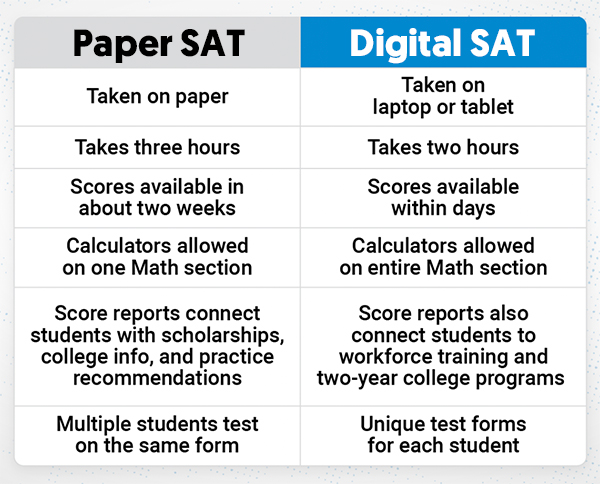Late-breaking in the standardized test community, the SAT is now digital. Despite a near century of booklets and bubble sheets, the SAT shifted to a computer-based platform on March 1st of this year.
New features on the Digital SAT:
Contrary to the paper-pencil SAT, the digital version is now adaptive. A student’s performance on both modules of reading and math determined the difficulty of their questions for the later sections. At first glance, this may seem like a blessing; if you perform poorly/well on the first module, you’ll get questions tailored to your skill level. However, the test prompts each student with a different question set, taking away from the

“standardized” appeal.
Aside from the adaptive feature, switching to a computer platform is a change in itself. The pacing is much faster in the reading sections, keeping many students working until the last second. However, many praised the exam, appreciating its easier-read passages and straightforward questions. In the math section, the Digital SAT has a built-in calculator (Desmos) for both sections. Beforehand, the SAT had one non-calculator and one calculator section. While a calculator is handy, you cannot physically write on the math questions. This leaves room for less contact with the questions. Question contact seems a bit far-fetched, but statistics show that the more students mark up a question, the more likely they are to understand the material and answer correctly.
Student Experience
Pre Exam:
From Juniors at APK, I got the inside scoop on how they prepared for the exam and their thoughts on the Digital SAT. The Blue and White got a hold of Saaya Lijjo, Jonathan Chen, and Hunter Mcshan. Saaya seemed most concerned with the adaptive feature: “As a test taker, seeing easier questions will freak me out because then I’ll know I wasn’t performing well.” Hunter felt similar about the adaptability, sharing that easier questions will make her “confidence go down on the second module.” Aside from the new feature, the computer platform offered a sense of familiarity. Jonathan Chen felt more comfortable with taking the exam digitally as “all the tests given in class and for final exams are online.” Taking an exam digitally also allows you to seamlessly go back and forth between each question, a well-known feeling in classroom-given tests.
Post Exam:
The two students interviewed after the exam were Juniors Jhenelle Francis and Jahfari Green. Both felt that the Digital SAT was a worthy alternative. Once a three-hour test, the Digital SAT just scrapes the two-hour mark. High school students unanimously favor this change, allowing students to reach their maximum testing potential. On the contrary, Jahfari felt that the shortened testing time had its pros and cons. He recalled “rushing through the last math section” since little time was left to solve the problems and check his work. Jhenelle mentioned that the math was from topics learned in middle school, taking her a longer time to recall featured concepts. However, in the English section, she mentioned that her AP Language Arts teacher, Ms.Gardiner, was a great help in honing her English and writing skills. Compared to her PSAT score, Jhenelle feels she will see “great improvement” due to her teacher’s study tips. Jahfari felt less prepared for the exam but showed no signs of nervousness. He explained that none of his classes taught material shown on the SAT, so he didn’t expect his teachers to do much to help prepare (For reference, he is enrolled in AP calculus and AP Lang).
All five juniors said they would be taking the assessment multiple times. As stated by Jonathan Chen, “I’m going to continue to take the SAT until I get a score that I can flex, like 1600.”
Teacher Experience
Mrs. Langford, the head testing administrator for the SAT, shared her experience with the new exam. The Blue and White was most interested in how the difference between the digital and paper-pencil SAT affected her role in administering the test. She shared that it took “the same amount of time, but the groundwork was very different.” Instead of stressing about booklets and testing sheets, her newfound concerns were whether students brought in their laptops or if they had working chargers. Relying on technology comes down to factors “out of our control,” such as electricity and the internet. Aside from these obstacles, she felt that the exam went very smoothly. “I prefer the digital SAT, and as a proctor, I loved it because it was shorter for both the teachers and the students.” Additionally, Langford also felt that the digital SAT eliminated timing errors. The Digital SAT solves many issues related to giving too much or too little time for the exam since students are on individual timers.
A side note mentioned was that the teachers put a lot of time into preparing to proctor this exam. In the room, there was a table of certificates laid out for the teachers, rewarding them with the completion of their training. Just as much as students, teachers put a lot of effort into creating a nice environment for the students.
Final Thoughts
To those who took the Digital SAT, good job for being the guinea pigs and making it through the short but grueling exam. We are manifesting great scores for everyone and a smooth road to further testing!







